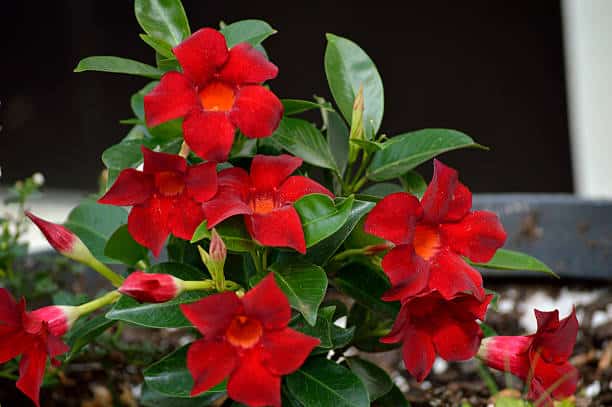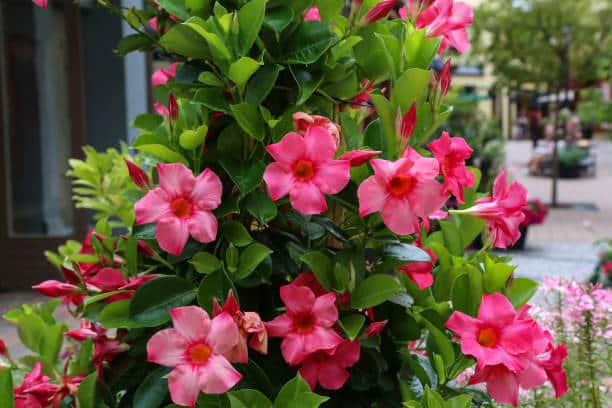By Lori Murray, Cameron County Master Gardener, Texas Superstar Specialist
If you want to fill in some gaps in your landscape created by our freeze, Mandevilla – a fast growing tropical woody vine – is the way to go. The caveat, however, is that if you plant it in a bed, it too could freeze if you cannot protect it adequately. A genus of flowering vines that grow in tropical and subtropical climates (zones 10 and 11), it doesn’t like temperatures below 45 degrees. It can be grown as a perennial in warm climates but is often grown in pots that can be brought inside in cold weather in cooler zones. As often happens, in our area we could grow it as a perennial, but we have to realize we could lose it some winter.
Mandevilla is also known as rocktrumpet for the shape of its five-petaled flowers which often have yellow throats. It can grow anywhere from 3 to 20 feet tall and up to 20 feet wide. The plant is a great climber and will be happy on a chain link fence or growing up a fancier trellis. (In fact, I made a mistake with the one I bought earlier this year. I planted it backing up to a trellis on my back fence and overlooked an old tomato cage in its proximity.
I got busy doing some of the many other things that needed to be done and when I got back to secure all the mandevilla tendrils to the trellis about a week or ten days later, it had twined itself around the tomato cage to the point that it couldn’t be loosened! So I’ll have a Mandevilla with a most unusual lump to see when I look out the window.)
These vines need lots of light, warmth and moisture which our climate can certainly provide. See that it gets at least 6 hours of sun a day. Drainage is extremely important; your soil needs to stay moist but it should not hold water. Some recommended sandy soil, but the one I have in my backyard is doing just fine in regular topsoil amended with expanded shale. (You can find expanded shale at Waugh’s Nursery in McAllen.) The soil can be neutral or even slightly acidic or alkaline but it must be well drained. The articles I read said that some varieties can be planted in hanging baskets; apparently the plant is significantly smaller when contained in a basket.
The most recommended way to grow mandevilla is by putting it in a large 20 inch container using a potting mix that drains well and an 18-6-12 slow release fertilizer every three months during the growth and blooming cycles from mid spring to late fall. A combination of 2 parts potting soil and one part builder’s sand was recommended for pots. Feeding them with a high phosphorous fertilizer during their blooming time will more than reward you with beautiful blooms. If you need to repot, go to the next size up for a pot. You can promote bushier growth by pinching back the stems in spring, but before you expose yourself to much of the sap, be sure it doesn’t irritate your skin.

Mandevilla, like poinsettias, can cause allergic reactions on the skin and can even be toxic if you’re foolish enough to eat it. Symptoms from skin contact with the sap include redness, pain, itching, and sores. Symptoms of poisoning by ingestion include upset stomach, nausea, vomiting, diarrhea, and sores around the mouth. Late winter or early spring is the time to prune back old crowded stems and shorten others. The Clemson website said that even if mandevilla is pruned almost to the ground, it will bloom the same summer on the new shoots which will develop from the base of the plant. Mandevilla plants don’t usually have any serious problems with insects or diseases although they could attract spider mites, scales, whitefly, and aphids. If you see any of that, use an insecticidal soap right away and lavishly.
There are over 100 species of mandevilla, offering a wide range of colors and sizes and scents. “Alice du Pont” is a woody twining evergreen vine which can get 20 feet tall in the ground but is much shorter when grown in a container. It has dark green, glossy leave 3 to 8 inches long. Large pink flowers (2 – 4 inches across) appear among the leaves. Even very small plants is 4 inch pots will bloom. It grows well in hanging baskets, especially if you pinch off the tips of new stems to induce density.
“Laza” or Chilean jasmine (although it is native to Argentine) grows to 15 feet with oblong or heart-shaped leaves. The flowers are clustered and white. Its roots are hardy to about 5 degrees. “Splendens” is similar to Alice du Pont but as the flowers age their pale pink deepens to rose. Its stems reach 10 – 15 feet in length. Also mentioned: “Red Riding Hood” has deep red flowers. “Summer Snow” has white flowers against a dark glossy foliage. “Yellow” is lower growing and shrubbier than most species and superb in hanging baskets. The University of Florida also offered publications on several cultivars.
SOURCES:
UF/IFAS Publications (University of Florida)
thespruce.com
Rio Series Mandevilla by Bonnie Garcia




